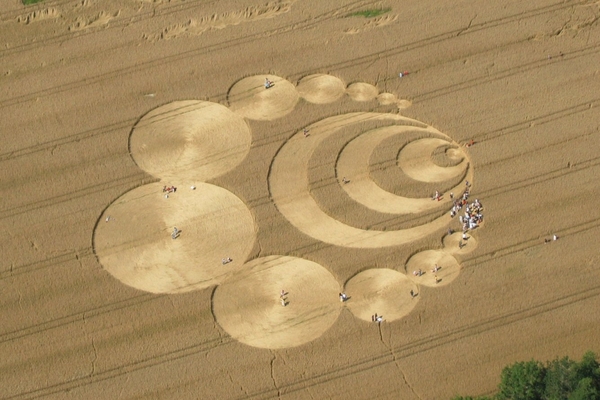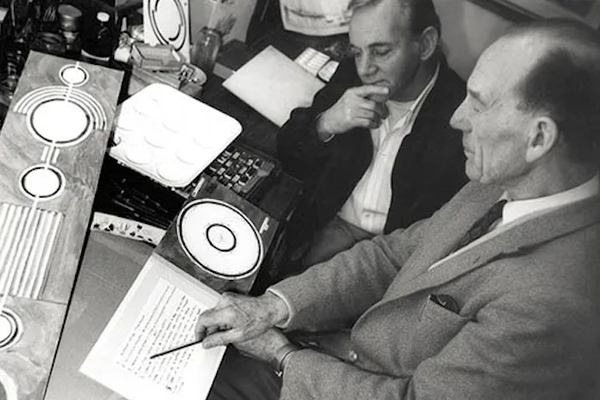Crop circles are a bit like Santa Claus. A certain amount of disbelief suspension is required if one wants to really extract full enjoyment from the phenomenon.
Crop circles are large, often intricate patterns that appear mysteriously in fields of crops, usually in wheat, barley or corn. They are typically formed by flattening the crops in specific areas, creating geometric shapes, complex designs, or even pictograms when viewed from above.
Reports of crop circles date back to the 17th century, but they gained widespread attention in the late 20th century, especially in the United Kingdom during the 1970s and 1980s.
While some crop circles are natural or accidental (caused by weather phenomena), most are created by humans using ropes, planks and other simple tools to flatten the crops in specific patterns. [Ed: Cover your ears and eyes if you are a “croppy”.]
There is a popular theory that crop circles are created by extraterrestrial beings or UFOs as a form of pictographic communication or as markings that evidence some kind of landing, though no scientific evidence supports this.Many crop circles are in fact known to be hoaxes or art installations created by enthusiasts, artists or pranksters. When Doug Bower and his co-conspirator Dave Chorley first created a representation of a “flying saucer nest” in a wheat field in Wiltshire, England, in 1976, they could not have foreseen that their work would become a cultural phenomenon. In 1991, in a series of interviews, they came clean and took credit for having created over 200 crop circles throughout England over those preceding 15 years. The number of reports of crop circles increased substantially after interviews with them.
According to websites that keep track of crop circles, there have been more than 12,000 created around the world. It’s a thing.
Crop circles have been featured in media, pop culture, and conspiracy theories, often depicted as mysterious or supernatural occurrences. The alien communication theory supporters tend to reckon that the patterns are often so intricate that a typical human being couldn't do them. But those conclusions are the essence of what the underground art movement has set out to achieve, i.e. to fool the public into believing that a supernatural force has created the works.
As suggested by Rob Irving and Peter Brookesmith in a 2009 exploration of “Crop Circles: The Art of the Hoax” in Smithsonian Magazine:
“Crop circles have become a lens through which we can explore the nature and appeal of hoaxes. Croppies regard human circle-makers as a nuisance, contaminators of the “evidence” and denounce them as “hoaxers” … In croppy culture, common parlance is turned on its head. The word “genuine” usually implies that something has a single, identifiable origin, of established provenance … It follows that the man-made circle is a hoax.”
They go on to suggest:
“The human soul longs for enchantment. Those who don’t find their instinctive sense of the numinous satisfied by art, literature or music—let alone the discoveries of science itself—may well turn to the paranormal to gratify an intuition that mystery dwells at the heart of existence. Such people are perfectly placed to accept hoaxed evidence of unexplained powers and entities as real.”
Both circle-makers and croppies are really engaged in a kind of game, whose whole purpose is to keep the game going, to prolong the mystery.
And, after all, who doesn’t have a part of them that wants to believe that Santa Claus is real?
Story Idea: Andrew Westcombe
_______________
References
wikipedia.org/wiki/Crop_circle
nytimes.com/2022/06/12/style/crop-circles
smithsonianmag.com/arts-culture/crop-circles-the-art-of-the-hoax-2524283
bbc.com/travel/article/20210822-englands-crop-circle-controversy
abc.net.au/news/rural/2016-07-26/scientific-crop-circle-research-held-back-by-ufo-links
Images
1. Collection of crop circles
2. Circular design made up of 409 individual circles, Wiltshire, UK, 2001
3. Stonehenge Down in England, 1996. Photo credit: Getty Images
4. Crop circle pattern from 2009, Wiltshire wheat field. Credit: Rob Irving
5. Aerial view of crop circles in Switzerland. Credit: Jabberocky
6. A crop circle in a barley field in Wiltshire, England
7. Crop circle makers Doug Bower (right) and Dave Chorley, 1991. Credit: Rob Irving
8. Front page of the British newspaper Today, Monday 9 September, 1991
9. Dave Chorley, one of the godfathers of crop circles, demonstrating with a plank of wood in 1991
10. Doug Bower, 2008. Credit: Rob Irving
11. Santa Claus comes down the chimney drawing circa 1870



























































































